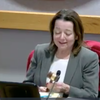Board to decide on shape of the school day for next year
GUILDERLAND — For close to two decades, the school board here has wrestled with setting a later start time for high school students since the science is unequivocal that adolescents need more sleep.
Last year, the pandemic caused high school classes to start much later as the district offered a hybrid program and then this school year, with full classes resuming, Guilderland began its long-anticipated schedule with a later high school start time.
But a combination of geography — the district is nearly 60 square miles with seven schools — heavy traffic on several major routes, and a nationwide shortage of bus drivers led to problems with students not arriving at school on time.
“The high school buses were never able to all arrive on time,” said Superintendent Marie Wiles.
High school Principal Michael Piscitelli said that the late bus arrivals this year “created a laissez-faire attitude about the start of school.”
At its next meeting, on May 24, the school board will vote on one of three plans Wiles presented at a meeting earlier this month.
The plans were developed by a current task force, which began meeting in the fall of 2018. An earlier task force had concluded in 2007 that the shape of the school day wouldn’t be changing.
Sleep habits
In 2018 and again this year, the task force surveyed the parents of elementary students and both the students themselves and the parents of middle school and high school students on sleep habits.
In both years, the majority of elementary students woke between 6 and 7 a.m.
The majority of middle school students woke between 6:30 and 7:30 a.m. in 2018, and this year woke a half-hour later, between 7 and 8 a.m.
The majority of high school students in 2018 woke between 5:30 and 6:30 a.m. while this year they woke an hour later between 6:30 and 7:30 a.m.
In 2018, the largest percentage of elementary students, 45 percent, got between nine and 10 hours of sleep while the largest percentage of middle school students got between eight and nine hours of sleep and the largest percentage of high school students got between six and seven hours of sleep.
This year, the predominant sleep hours remained roughly the same for elementary and middle school students.
At the high school, 30 percent of students said they got six to seven hours, 30 percent said they got seven to eight hours, 21 percent got five to six hours, 10 percent got eight to nine hours, and 2 percent got nine to 10 hours of sleep.
So there was a 12-percent increase in the seven-to-eight-hour range for high school students but a 5-percent decrease in the six-to-seven-hour range.
Three plans
“They all come with pros and cons,” said Wiles of the three “do-able” plans:
— Elementary first
In this plan, the district’s five elementary schools would start at 7:30 a.m. followed by the middle school at 8:15 a.m., and then the high school at 9:10 a.m.
This plan is a modification of what the district is doing this year with the elementary day starting a bit earlier.
It is consistent with research on sleep for adolescents. Other advantages are: There is no unsupervised time at the beginning or end of the high school day, and no need to shorten the high school instructional day; also five minutes are added to the elementary school day.
On the down side, pick-up times for the elementary school level is very early and the middle school day ends late; also supervision is needed at the start of the middle school day and student athletes would miss instructional time if they have competitions after school. Also bus runs for technical-education students don’t align well.
— High school first
In this plan, high school would start at 7:30 a.m., the elementary schools would start at 8:05, and the middle school would start at 8:55 a.m.
In this plan, tech-ed bus runs align better, freeing four runs and saving money. There’s an earlier start and end time at the middle school and athletes don’t have to miss classes. Elementary students would be picked up later, and there is time for help built into the school day.
On the down side, high school students would get less sleep and elementary students would lose 15 minutes of instructional time daily; and
— Middle school first
In this plan, the middle school would start at 7:25 a.m., the high school would start at 8:33 a.m., and the elementary schools would start at 9:10 a.m.
The plan is consistent with sleep research for high school students and builds time for extra help into the high school schedule. The plan also means no before-school supervision is needed at the middle school or high school and less after-school child care is needed at elementary schools. Also, middle school athletes would lose less instructional time.
The downside is the schedule is not consistent with the sleep needs of middle school students, 13 minutes of instructional time are lost for high school athletes at the end of the day, and before-school care is needed at the elementary level. Also, there is an increased gap with time for the technical-education bus runs.
Varied views
Board members were divided on which plan is best.
Rebecca Butterfield, a pediatrician who had originally been a proponent of the later start time for high school students, said she favored the second plan, noting the time to help students is built into the day. “It saddens me to say it,” she said of giving up on the later high school start time.
Board member Barbara Fraterrigo, however, lobbied for the first plan, stating that elementary school parents don’t mind the early start.
Board President Seema Rivera disagreed, saying her child gets on the school bus in the dark, “which is insane.”
She said of the later start time for the high school, “I just don’t see the gains.”
Board member Nathan Sabourin said high school students weren’t getting more sleep, as intended, but just shifting their sleep times later.
“We don’t have a good way to collect data on our student experiences … A hundred other things went wrong because of COVID,” said Wiles, adding, “Attendance is terrible this year. A lot of students are struggling academically.”
It would take an expensive capital project to solve the “nightmare” of the single way in and out of Farnsworth Middle School, said Wiles. A bond issue that was defeated in 2019 had included $3 million to reconfigure what is now a bottleneck.
“We’ve always had other priorities when money gets tight,” said Wiles. “It’s on the list.”



